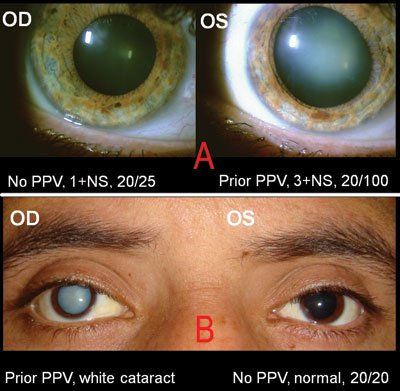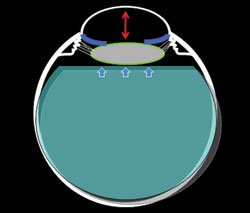Cataract surgery can be more challenging after vitrectomy
 Uday Devgan |
Pars plana vitrectomy is a safe, small-gauge, effective surgery that is essential in the treatment of a variety of posterior segment pathologies, including retinal detachments, diabetic retinopathy and macular lesions. But performing a vitrectomy, particularly with the use of intraocular gas, can induce cataracts, even in younger patients.
Cataract surgery in an eye that has had a prior vitrectomy can be challenging because the absence of the vitreous can lead to anatomic alterations such as an overly deep anterior chamber and less support of the crystalline lens. Successful cataract surgery in these patients is important to restore their vision as well as to give the vitreoretinal specialists a clear view in order to monitor the posterior segment.
Preoperative evaluation
The patient’s history is particularly important to determine the onset of symptoms and the development of the cataract. After most pars plana vitrectomies, cataracts develop slowly, over the course of months or years after retinal surgery, in the form of increased nuclear sclerosis and often posterior subcapsular opacities. The use of intraocular gas as a retinal tamponade may induce cataract changes at a somewhat more rapid rate, but it is still typically months before the patient notices a visual decline. If the patient reports a history of quickly developing a cataract, such as a white cataract, days or weeks after the vitrectomy, then iatrogenic damage to the lens capsule should be suspected. While it is uncommon, it is possible for the pars plana vitrectomy instruments to damage the posterior lens capsule, which can rupture and then cause the lens to opacify very quickly.
 (A) The top patient had an uncomplicated pars plana vitrectomy and gas bubble in the left eye to repair a retinal detachment. Ten months later, she presents with a nuclear sclerotic cataract in the left eye, which has limited the vision to 20/100. The cataract happened gradually over the course of months and is due to the vitrectomy and former intraocular gas bubble. (B) The bottom patient developed a white cataract shortly after undergoing a pars plana vitrectomy and gas bubble to repair a retinal detachment. The cataract progressed rapidly over the course of just a few weeks and is likely due to compromise of the posterior lens capsule. Images: Devgan U |
|
|
|
|
The vitreous in a virgin eye (left) is
semi-solid, thick and viscous. This allows it to help support the cataract
during surgery when the patient is supine. This results in a normal anterior
chamber depth. In an eye that has undergone a prior vitrectomy (right), aqueous
and saline have replaced the vitreous, resulting in a fluid-filled eye that
does not provide additional cataract support. The anterior chamber tends to be
overly deep during cataract surgery. |
|
Clinical examination should include careful evaluation of the posterior capsule by either slit lamp or ultrasound, if direct visualization is not possible. If the ultrasound shows an abnormally large lens thickness or an out-pouching of the posterior lens surface, a defect in the posterior lens capsule likely exists. IOL calculations may be somewhat less accurate due to difficulty in estimating the postop effective lens position.The absence of vitreous and possible prior damage to zonules may cause the IOL to sit more posterior than predicted, resulting in a hyperopic surprise. This is why aiming for a mild degree of postop myopia by using a slightly higher-powered IOL tends to give better results. I prefer using three-piece monofocal acrylic IOLs in these eyes because there are more options for lens fixation, such as in-the-bag, in-the-sulcus and sulcus placement of the haptics with optic capture through the capsulorrhexis. In addition, the acrylic material minimizes condensation on the optic and adhesion to silicone oil if a repeat vitrectomy is needed in the future.
Intraoperative techniques
The vitreous in a virgin eye is semi-solid, thick and viscous. These properties allow it to help support the cataract during surgery when the patient is supine. This results in a normal anterior chamber depth and a more routine cataract surgery. In an eye that has undergone a prior vitrectomy, saline and aqueous have replaced the vitreous, resulting in a fluid-filled eye that does not provide additional support of the cataract during phacoemulsification. This causes the anterior chamber to be overly deep during cataract surgery. To address this, the infusion pressure can be decreased by lowering the bottle height on the phacoemulsification machine. To compensate for lower infusion, the aspiration flow rate should also be dropped.
Additionally, posterior support can be increased by giving a retrobulbar block because the anesthetic bolus will tend to provide pressure to the back of the eye. If there is reverse pupillary block, caused when the iris makes a tight seal on the anterior lens capsule, this can be solved by tenting up the iris with a second instrument or even by placing a single iris hook. These eyes may also have zonular damage or laxity, which can lead to difficulties during cataract surgery. If there is a posterior capsule rupture, either from the vitrectomy or cataract surgery, the lens nucleus should be brought forward, out of the capsular bag, and viscoelastic should be placed behind it to support it. If any cataract pieces are displaced into the posterior segment, they will rapidly descend onto the retina due to the lack of vitreous. These pieces are best removed by the vitreoretinal surgeon using a pars plana approach.
Postoperative management
Patients who undergo cataract surgery after a prior retinal surgery are at higher risk for some postop complications. Patients with prior macular surgery are more prone to cystoid macular edema, even after a beautifully performed cataract surgery. These patients should be treated with anti-inflammatory medications for a prolonged period, and their macular status should be monitored at postop visits. Patients with prior retinal detachment surgery are at a higher risk for a recurrent detachment after cataract surgery, so their retinal periphery should be checked carefully. In addition, it may take longer for these patients to heal after surgery and to achieve a stable postop refraction.
Patients who undergo a pars plana vitrectomy are more likely to develop a cataract, typically months to years after their initial retinal surgery. With careful preop evaluation, select intraoperative techniques and close postop monitoring, these patients can achieve excellent results from their cataract surgery and restoration of their vision.
For further reading:
- Machemer R. The development of pars plana vitrectomy: a personal account. Graefes Arch Clin Exp Ophthalmol. 1995;233(8):453-468.
- Machemer R, Buettner H, Norton EW, Parel JM. Vitrectomy: a pars plana approach. Trans Am Acad Ophthalmol Otolaryngol. 1971;75(4):813-820.
- Uday Devgan, MD, FACS, FRCS (Glasg), is in private practice at Devgan Eye Surgery in Los Angeles, Beverly Hills and Newport Beach, Calif. He can be reached at 11600 Wilshire Blvd., Suite 200, Los Angeles, CA 90025; 800-337-1969; fax 310-388-3028; e-mail: devgan@gmail.com; website: www.devganeye.com.



